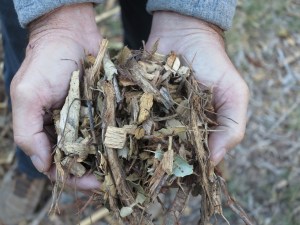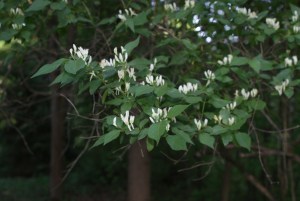By Jim Downer

As many avid GP readers are aware, mulches are a common horticultural tool that help gardeners maintain soil moisture, nutrient content, weed suppression and assist in disease prevention. The best mulch is made from chipped tree trimmings wastes and has a large wood content. Coarse “arborist chips” mulch is fast becoming one of the most frequently sought after mulches for residential landscapes. It is very effective and contributes to significant soil improvements over time. As chip mulches decompose, the fruiting bodies of fungi are often seen growing up through mulch. Sometimes, as gardeners work in previously mulched beds, they see mycelium or cordons (rhizomorphs) of mulch fungi growing through the mulch. Some gardeners are not fond of finding mushrooms growing in their mulch and have termed these as “nuisance fungi”. There have even been extension leaflets on nuisance fungi and how to rid them from your garden!! Fungi are a natural part of mulch breakdown and their presence in mulches is desirable!

The first encounter many gardeners have with mulch fungi is when they see “mold” growing in the chips or at the interface of mulch and soil. Mold gets a bad rap with many homeowners when they find it after water damage in their house, so perhaps they assume it is also bad for their gardens. Mold abatement in homes has become a specialized industry, and while the spores of some fungi can be human pathogens, fungi are not to be feared in gardens unless your immune system is damaged or otherwise compromised. Unlike houses, gardens are a good place for fungi to grow and thrive.
 Fungi absorb water and nutrients from their hyphae which grow into their food (mulch particles). The absorptive lifestyle of fungi is unique. Since fungi have no internal digestive systems, they rely on excreting enzymes outside their bodies and into their food which breaks down the substrate so they can absorb it. By doing so, they also release minerals, sugars, amino acids and many other compounds for other microbes and plants to utilize. Fungi are mostly saprophytes or decomposers, and their role is to release organic nutrients to soil so they can be recycled. This is why mulches are so beneficial to woody plants. Without fungi, forest litter would pile up largely undecomposed because bacteria and other microbes are less efficient in breaking down cellulose. Some fungi are mutualistic partners with woody plant roots. Ectomycorrhizal (EM) fungi rely on interactions between trees themselves and the litter or mulch layers under trees. Fruiting bodies of EM fungi may appear as mushrooms or puff balls in or next to mulches.
Fungi absorb water and nutrients from their hyphae which grow into their food (mulch particles). The absorptive lifestyle of fungi is unique. Since fungi have no internal digestive systems, they rely on excreting enzymes outside their bodies and into their food which breaks down the substrate so they can absorb it. By doing so, they also release minerals, sugars, amino acids and many other compounds for other microbes and plants to utilize. Fungi are mostly saprophytes or decomposers, and their role is to release organic nutrients to soil so they can be recycled. This is why mulches are so beneficial to woody plants. Without fungi, forest litter would pile up largely undecomposed because bacteria and other microbes are less efficient in breaking down cellulose. Some fungi are mutualistic partners with woody plant roots. Ectomycorrhizal (EM) fungi rely on interactions between trees themselves and the litter or mulch layers under trees. Fruiting bodies of EM fungi may appear as mushrooms or puff balls in or next to mulches.


Sometimes fruiting bodies (mushrooms) push through mulch, but are not the result of mulch presence. Pathogens such as Armillaria mellea (oak root fungus) can form through mulch layers or turfgrass, but they are fruiting off the dead roots of their tree host. Similarly, the inky cap mushrooms (Coprinus spp.) often grow saprophytically on dead roots (they are not the cause of root death) and will push through litter layers. Coprinus are good indicators that a tree has dead roots. Coprinus is not a plant pathogen, and mulch does not increase prevalence of pathogens in landscapes. As we have discussed many times in the blog, mulches are unlikely to spread or support plant pathogenic fungi.

Another way to view the role of fungi is the chemistry that they facilitate in soil. Mulch is organic matter, which has a high concentration of carbon. Carbon is transformed from a solid form into a gas – carbon dioxide – through the action of microbes (mostly fungi). So oxidation of carbon is driven by fungi growing through their substrate (forest litter in forests or mulch in gardens). In mulching systems this is a slow process taking a few years. In composting systems it is rapid, taking months with the added energy of mechanical turning etc. Slow decomposition of organic matter is useful, as the benefits of mulch in suppressing weeds, slowing evaporation from soils etc. are maintained over time. Slowly oxidizing carbon means that it will be around longer, creating less greenhouse gasses than in the composting process.
In publications that recommend ways for “dealing with nuisance fungi” it is suggested to let mulch dry out, which stops the action of the fungi. This is one of the most harmful things that can be done for active mulch zones. Killing the fungi in mulch also stops their oxidation of carbon, subsequent nutrient release and support for the high microbial activity in mulches that benefit both plants and disease suppressing fungi that plants rely upon to maintain their health. While fungi can reactivate when dry mulches are moistened, their biomass is damaged by severe drought which also injures plant roots as well.
All good things come to an end or as our physics friends say, “Entropy increases!!” So as labile (easily metabolized) carbon is used up in fresh mulches, fungi go into spore bearing or reproductive phases and begin to make fruiting bodies. As long as there is labile carbon, fungi will thrive and grow mycelium and hyphae into their food. When carbon is being used up (or when there is sufficient mycelium), fruiting bodies start to form. To maintain these processes, it is important to add fresh mulch over the old decaying mulch. Once or twice a year depending on temperature and moisture levels. Along the way, some mulch may develop fungal fruiting bodies. Fruiting bodies may resemble mushrooms, puff balls, earth stars, bird nest fungi, or simply resemble paint that has been splashed on the wood chips. They are only trying to survive by developing spores which will later spread onto fresh mulch materials. Most mulch fungi have very ephemeral fruiting bodies, so even if they are seen to be a “nuisance”, they will only be around for a very short time before they also decompose and become part of the remaining mulch layer or soil.

One very common group of organisms seen in mulch and mistaken for fungi are the slime molds. They are not related to fungi, but do develop spores and have a mobile (plasmodium) phase where they can be seen to slowly move from one spot to another. Eventually, when the plasmodial stage is done feeding, the sporangial phase is made and they turn into spores. The most commonly encountered slime mold in mulch beds is the dog barf fungus, a slime mold called Fuligo spetica. Fuligo is dramatic because it can appear overnight and is large (a patch of the sporangium can be several inches across). When kicked, Fuligo bursts into dark spores that will fly up into the air. Slime molds are also saprophytes and live on the decomposing organic matter in mulch. They pose no threat to humans or garden plants.

Fungi in the mulch are a good thing and indicate that moisture, temperature and organic matter are at the correct levels for high microbial activity! This is what creates a healthy soil and ensures healthy garden plantings.






































